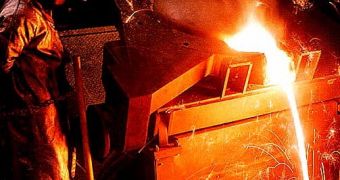Steel is one of the strongest compounds known to man, but also relatively expensive to make since it becomes brittle at low temperatures. To counter this effect, during the fabrication process expensive additives must be mixed with it. Japanese researchers claim that they have found a way to create steel that resists even at frigid temperatures without the need for costly alloys by simply altering the crystalline structure of steel to enhance its strength.
Steel is an alloy of iron and carbon and generally crystallizes in a grain-like rounded shape. Yuuji Kimura from the National Institute of Materials Sciences says that through the new fabrication method the crystalline grain takes a much longer shape, similar to that of fibers. When subjected to temperatures well below freezing point regular steel - without additives - starts losing the bond between the crystalline grains, thus becoming brittle.
This is experienced at about -30 degrees Celsius. However, by adding nickel, cobalt and vanadium, the bonds between individual crystalline grains is enhanced, allowing it to remain malleable even at lower temperatures. The steel fabrication method developed by Kimura renders steel brittle at a temperature on -100 degrees Celsius, similar to the properties of alloyed steel.
Fibrous steel grains are created by applying a tempforming method, involving a heat and mechanical treatment. Steel is first formed into a plate which is then rolled into a rod, while heated at about 1200 degrees Celsius. The rod is then cooled to 500 degrees Celsius, and compressed into bars to give the steel grain a fibrous shape.
"It shows that there are still very interesting things to be done - and learned - in the ancient field of ferrous metallurgy. The combination of strength and toughness that is comparable to that of modern steels that are very rich in alloy content and, therefore, very expensive", said Bill Morris, material scientist at the University of California.
High strength steel created through this method would enable the manufacturing of light strong tubing for a wide variety of applications, such as in constructing lightweight vehicles with reduced exhaust emissions but also for applications involving oil exploration in the polar areas of the globe.

 14 DAY TRIAL //
14 DAY TRIAL //